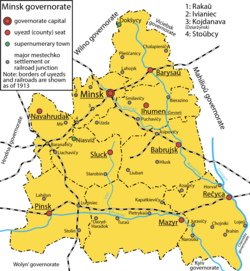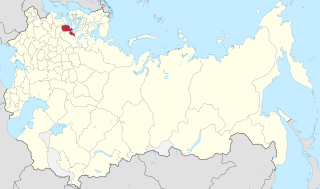
The Saint Petersburg Governorate was a province (guberniya) of the Russian Empire, with its capital in Saint Petersburg. The governorate was composed of 44,613 square kilometres (17,225 sq mi) of area and 2,112,033 inhabitants. It was bordered by Estonian and Livonian Governorates to the west, Pskov Governorate to the south, Novgorod Governorate to the east, Olonets Governorate to the northeast, and Vyborg Governorate of the Grand Duchy of Finland to the north. The governorate covered most of the areas of modern Leningrad Oblast and Ida-Viru, Jõgeva, Tartu, Põlva, and Võru counties of Estonia.

Mga is an urban locality in Kirovsky District of Leningrad Oblast, Russia. Population: 10,212 (2010 Census); 9,613 (2002 Census); 9,852 (1989 Census).

Yekaterinoslav Governorate was an administrative-territorial unit (guberniya) of the Russian Empire, with its capital in Yekaterinoslav. It bordered Poltava Governorate to the north, Don Host Oblast to the east, Sea of Azov to the southeast, Taurida Governorate to the south, and Kherson Governorate to the east, and covered the area of the Luhansk, Donetsk, Dnipropetrovsk, and Zaporizhzhia Oblasts of modern Ukraine.
Krasny Kholm is a town and the administrative center of Krasnokholmsky District in Tver Oblast, Russia. Population: 5,608 (2010 Census); 6,396 (2002 Census); 7,875 (1989 Census).
Within the framework of administrative divisions, Arkhangelsk Oblast is divided into six cities and towns of oblast significance, twenty-one districts, and two island territories. Besides, Mirny is a town under the federal government management.
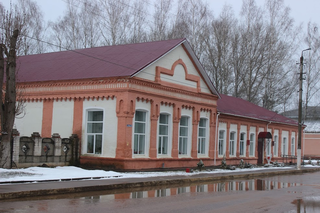
Krasny is an urban locality and the administrative center of Krasninsky District of Smolensk Oblast, Russia, located at the confluence of the Svinaya and the Mereyka Rivers 67 kilometers (42 mi) southwest of Smolensk. Population: 4,349 (2010 Census); 4,714 (2002 Census); 5,087 (1989 Census).

Vsevolozhsky District is an administrative and municipal district (raion), one of the seventeen in Leningrad Oblast, Russia. It is located in the central northwestern part of the oblast on the Karelian Isthmus and borders with Priozersky District in the north, Kirovsky District in the south, Vyborgsky District in the northwest, Nevsky, Krasnogvardeysky, Kalininsky, Vyborgsky, and Kurortny Districts of the federal city of St. Petersburg in the west, and is washed by Lake Ladoga in the east. The area of the district is 3,036.4 square kilometers (1,172.4 sq mi). Its administrative center is the town of Vsevolozhsk. Population : 153,045 (2010 Census); 131,233 ; 135,318 (1989 Census).

The Vilna Governorate was a province (guberniya) of the Northwestern Krai of the Russian Empire. In 1897, the governorate covered an area of 41,907.9 square kilometres (16,180.7 sq mi) and had a population of 1,591,207 inhabitants. The governorate was defined by the Minsk Governorate to the south, the Grodno Governorate to the southwest, the Suwałki Governorate to the west, the Kovno and Courland Governorates to the north, and the Vitebsk Governorate to the east. The capital was located in Vilna (Vilnius). The city also served as the capital of Vilna Governorate-General, which existed until 1912. The area roughly corresponded to the Vilnius Region, which was later occupied by Germany, Bolsheviks, and Poland.

Shemakha Governorate was an administrative-territorial unit (guberniya) of the Caucasus Viceroyalty of the Russian Empire, with its administrative center in Shemakha (Shamakhi). Following the earthquake of 1859, the capital was transferred and the province became known as the Baku Governorate.

Vyatka Governorate was an administrative-territorial unit (guberniya) of the Russian Empire and the Russian SFSR from 1796 to 1929, with its capital in Vyatka. The area of the governorate roughly corresponds to modern-day Kirov Oblast and Udmurtia.
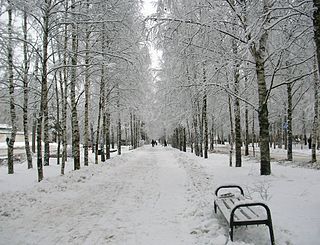
Kaduy is an urban locality and the administrative center of Kaduysky District of Vologda Oblast, Russia, located on the Voron River at the confluence with the Sivets River, 56 kilometers (35 mi) west of the city of Cherepovets. Municipally, it is incorporated as Kaduyskoye Urban Settlement, one of the two urban settlements in the district. Population: 11,284 (2010 Census); 11,798 (2002 Census); 11,153 (1989 Census).

Vladimir Governorate was an administrative-territorial unit (guberniya) of the Russian Empire, the Russian Republic and the Russian SFSR, which existed in 1796–1929.

Vitebsk Governorate was an administrative-territorial unit (guberniya) of the Russian Empire, with the seat of governorship in Vitebsk. It was established in 1802 by splitting Belarusian Governorate and existed until 1924. Today most of the area belongs to Belarus, the northwestern part to Latvia and the northeastern part to Pskov and Smolensk Oblasts of Russia.Together with the Vilna, Kovno, Grodno, Minsk, and Mogilev Governorates, it formed the Northwestern Krai. The provincial city was Vitebsk, the largest city was Dvinsk.
Caucasus Governorate was an administrative division (guberniya) of the Russian Empire, which existed from 1802 until 1822. Its seat was located in Georgiyevsk. The governorate was located in the south of the European part of the Russian Empire. In 1822, the governorate was abolished and transformed into Caucasus Oblast, with the administrative center in Stavropol. In terms of modern administrative divisions of Russia, the area of Caucasus Governorate is currently split between Stavropol and Krasnodar Krais, Rostov Oblast, and the Republics of Kabardino-Balkaria, North Ossetia–Alania, Ingushetia, Chechnya, Dagestan, and Kalmykia, with the major part of it being located in Stavropol Krai.

Kiev Governorate was an administrative-territorial unit (guberniya) of the Tsardom of Russia and the Russian Empire. It was established in December 1708 as one of the eight guberniyas first created during the reforms of Peter the Great.
Imeni Sverdlova is an urban locality in Vsevolozhsky District of Leningrad Oblast, Russia, located on the right bank of the Neva River, southeast of the center of Saint Petersburg and opposite to Ust-Izhora. Municipally it is incorporated as Sverdlovskoye Urban Settlement, one of the eight urban settlements in the district. Population: 9,260 (2010 Census); 9,197 (2002 Census); 8,905 (1989 Census).

Tver Governorate was an administrative-territorial unit (guberniya) of the Russian Empire and the Russian SFSR, which existed from 1796 until 1929. Its seat was in Tver. The governorate was located in the center of the European part of the Russian Empire and bordered Novgorod Governorate in the north, Yaroslavl Governorate in the east, Vladimir Governorate in the southeast, Moscow Governorate in the south, Smolensk Governorate in the southwest, and Pskov Governorate in the west.

Simbirsk Governorate was an administrative-territorial unit (guberniya) of the Russian Empire and the Russian SFSR, which existed from 1796 to 1928. Its administrative center was in the city of Simbirsk, renamed Ulyanovsk in 1924.

Tomsk Governorate was an administrative-territorial unit (guberniya) of the Russian Empire, the Russian Republic, and the Russian SFSR, which existed from 1804 to 1925 as part of Siberian Governorate-General (1804–1822) and West Siberian Governorate-General (1822–1882). Its capital was in Tomsk.
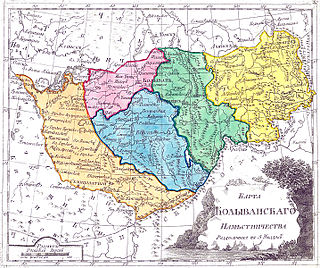
Kolyvan Viceroyalty, later Kolyvan Governorate, was an administrative-territorial unit of the Russian Empire, which existed in 1783–1796.


